Security
Integrated Disaster Preparedness Drill
Building Resilience Through Simulation, Coordination, and Awareness
Posted On: 10 AUG 2025 11:48AM
“When it comes to disaster management, a proactive approach is always better than a reactive one.”
- Prime Minister Narendra Modi
Key Takeaways
- The Disaster Management Act, 2005 provides the legal and institutional framework for disaster prevention, preparedness, and response at all levels.
- India faces multi-hazard vulnerability, with over 58% of landmass prone to earthquakes, 68% of cultivable land to drought, and increasing instances of flooding, cloud bursts, cyclones
- NDMA’s DMEx Guidelines mandate regular simulation-based exercises to test disaster plans, coordination, and readiness.
- The National Policy on Disaster Management, 2009 shifted focus from relief to preparedness, promoting a culture of risk reduction and resilience.
- Exercise Suraksha Chakra was the first integrated multi-state mock drill in Delhi-NCR, simulating a large-scale earthquake across 55 locations.
Introduction
India, owing to its vast and diverse geography, is vulnerable to a wide range of natural and human-induced disasters—including earthquakes, floods, cyclones, droughts, tsunamis, landslides, and industrial accidents. With over 27 states and union territories identified as disaster-prone and more than 58% of the landmass susceptible to seismic activity, disaster preparedness is not a choice—it is a necessity.
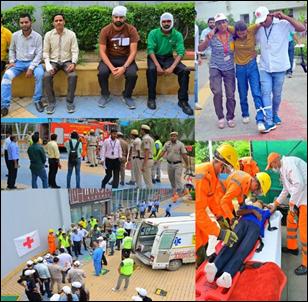
To ensure systemic and organized disaster response, India has established a robust institutional framework:
- The National Disaster Management Authority (NDMA) is the apex body responsible for framing policies, plans, and guidelines.
- State Disaster Management Authorities(SDMAs) and District Disaster Management Authorities (DDMAs)implement these frameworks at regional and local levels.
- Strategic initiatives like Disaster Management Exercises (DMEx) play a critical role in testing response readiness and institutional coordination.
- The National Disaster Response Force (NDRF), a specialized force under the Ministry of Home Affairs, plays a frontline role in search, rescue, and relief operations.
- Local bodies, NGOs, and community volunteers are also essential stakeholders in India’s comprehensive disaster management approach.
Various Disaster Preparedness exercises are conducted in this context to reinforce India’s culture of preparedness and community resilience, aligning with international frameworks like the Sendai Framework for Disaster Risk Reduction.
The NDMA has released different guidelines for various disasters, including:
|
Disaster / Hazard Type
|
Relevant NDMA Guideline(s)
|
|
Earthquake
|
Management of Earthquakes; Simplified Safety Guidelines
|
|
Floods (Urban/Riverine) & Tsunami
|
Management of Floods; Urban Flooding; Tsunami Guidelines
|
|
Cyclones & GLOFs
|
Cyclone Management Guidelines; Glacial Lake Outburst Floods (GLOF) Guidelines
|
|
Landslides & Snow Avalanches
|
Landslide Risk Management Strategy
|
|
Drought
|
Management of Drought
|
|
Heat Waves, Cold Waves & Frost
|
Heat Wave Action Plan; Cold Wave & Frost Management Guidelines
|
|
Thunderstorm, Lightning, Dust, Hailstorms, Strong Winds
|
Prevention & Management of Thunderstorms, Lightning & Associated Hazards
|
|
Biological Disasters
|
Management of Biological Disasters
|
|
Chemical Disasters
|
Chemical Disaster Management Guidelines
|
|
Nuclear/Radiological Emergencies
|
Management of Nuclear and Radiological Emergencies
|
|
Mass-Casualty & Medical Preparedness
|
Medical Preparedness and Mass Casualty Management
|
|
Urban Infrastructure Safety
|
Seismic Retrofitting; Hospital Safety Guidelines; School Safety Guidelines
|
|
Temporary Shelter & Relief Standards
|
Guidelines on Temporary Shelter; Minimum Standards of Relief
|
|
Public Safety in Specific Contexts
|
Boat Safety; Museum & Cultural Heritage Site Safety Guidelines
|
|
Institutional Systems & Response Mechanisms
|
Incident Response System (IRS); EOC Guidelines; HADR; CBDRR; DMEx Guidelines
|
|
Psychological Support & Vulnerable Groups
|
Mental Health & Psychosocial Support (MHPSS); Disability-Inclusive DRR Guidelines
|
Understanding Disasters and Disaster Management
What is a Disaster?
According to the Disaster Management Act, 2005, a “disaster” means a catastrophe, mishap, calamity or grave occurrence in any area, arising from natural or man-made causes, or by accident or negligence which results in substantial loss of life or human suffering or damage to, and destruction of, property, or damage to, or degradation of, environment, and is of such a nature or magnitude as to be beyond the coping capacity of the community of the affected area.
What is Disaster Management?
According to the Disaster Management Act, 2005, “disaster management” refers to a continuous and integrated process involving the planning, organising, coordinating, and implementing of measures essential or expedient for effectively handling disasters. This includes the prevention of danger or threat of any disaster, mitigation or reduction of the associated risks and consequences, and the building of necessary capacities. It also encompasses preparedness to deal with disasters, prompt response to any threatening situation, and assessment of the severity or magnitude of disaster effects. Furthermore, disaster management involves evacuation, rescue, and relief operations, as well as long-term rehabilitation and reconstruction efforts.
Why do we need Disaster Management in India?
India, due to its unique geo-climatic and socio-economic conditions, is vulnerable, in varying degrees, to floods, droughts, cyclones, tsunamis, earthquakes, urban flooding, landslides, avalanches and forest fire. Out of 36 States and Union Territories (UTs) in the country, 27 are disaster prone. 58.6% landmass is prone to earthquakes of moderate to very high intensity; 12% land is prone to flood and river erosion; out of 7,516 km coastline, 5,700 km is prone to cyclones and tsunamis; 68% of the cultivable land is vulnerable to drought, hilly areas are at risk from landslides and avalanches, and 15% of landmass is prone to landslides.
Further, a total of 5,161 Urban Local Bodies (ULBs) are prone to urban flooding. Fire incidents, industrial accidents and other manmade disasters involving chemical, biological and radioactive materials are additional hazards, which have underscored the need for strengthening mitigation, preparedness and response measures.
Evolution of Disaster Management Exercises in India
Over the years, India’s approach to disaster drills has evolved consistently from conducting informal local-level drills to structured, multi-agency execises. Disaster management efforts have gained momentum post the Disaster Management Act, 2005. Disaster management drills like Mumbai Emergency Management Exercise (MEMEx), 2008 and Chennai Emergency Management Exercise (CEMEx), 2011 marked a shift towards the importance of coordinated drills and documentation which spurred several state-level disaster management exercises, supported by NDMA. These efforts gradually became the foundation to India’s disaster risk reduction framework.
Disaster Management Act, 2005
The Disaster Management Act, 2005 is a central legislation enacted to ensure effective management of disasters in India. It provides a comprehensive legal and institutional framework at the national, state, and district levels for disaster prevention, mitigation, preparedness, response, relief, rehabilitation, and reconstruction. The Act lays the foundation for the establishment of statutory bodies such as the National Disaster Management Authority (NDMA), State Disaster Management Authorities (SDMAs), and District Disaster Management Authorities (DDMAs), along with specialized agencies and dedicated funds for disaster response and mitigation.
Key Objectives of the Act:
- To ensure a proactive and coordinated disaster management framework across the country.
- To establish institutional mechanisms for disaster preparedness, mitigation, response, and recovery.
- To integrate disaster risk reduction into development planning and ensure community participation.
- To provide for the constitution of disaster-specific response and mitigation funds.
- To facilitate capacity-building, awareness, training, and information dissemination.
Key Provisions of the Act:
- Establishes NDMA, SDMAs, and DDMAs for disaster governance.
- Mandatespreparation of disaster management plans at all levels.
- Provides for National, State, and District Disaster Response and Mitigation Funds.
- Empowers authorities to requisition resources and issue emergency directions.
- Prescribes minimum standards for relief, shelter, food, and health in disaster situations.
- Creates the National Institute of Disaster Management and NDRF for training and response.
- Assigns roles to central, state, district, and local bodies for coordinated action.
- Imposes penalties for obstruction, false claims, and misuse of relief materials.
- Ensures integration of disaster mitigation into development planning.
- Promotes awareness, capacity-building, and training across government levels.
National Disaster Management Authority (NDMA)
The National Disaster Management Authority (NDMA), headed by the Prime Minister of India, is the apex body for disaster management in India that spearheads and implements a holistic and integrated approach to disaster management in India.
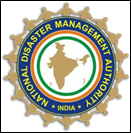
NDMA has the following responsibilities:
- Lay down policies on disaster management.
- Approve the National Plan.
- Approve plans prepared by theMinistries or Departments of the Government of India in accordance with the National Plan.
- Lay down guidelines to be followed by the State Authorities in drawing up the State Plan.
- Lay down guidelines to be followed by the different Ministries or Departments of the Government of India for the Purpose of integrating the measures for prevention of disaster or the mitigation of its effects in their development plans and projects.
- Coordinate the enforcement and implementation of the policy and plans for disaster management.
- Recommend provision of funds for the purpose of mitigation.
- Provide such support to other countries affected by major disasters as may be determined by the Central Government.
- Take such other measures for the prevention of disaster, or the mitigation, or preparedness and capacity building for dealing with threatening disaster situations or disasters as it may consider necessary.
- Lay down broad policies and guidelines for the functioning of the National Institute of Disaster Management.
National Disaster Response Force (NDRF)
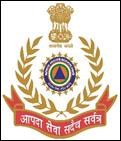
The National Disaster Response Force (NDRF) is India’s premier specialized force constituted under the Disaster Management Act, 2005, for effective response to both natural and man-made disasters. Established in2006, the NDRF operates under the Ministry of Home Affairs and is tasked with providing specialized search, rescue, and relief services during emergencies.The NDRF has been at the forefront of numerous national operations, including major rescue efforts during the Kosi floods (2008), Jammu & Kashmir floods (2014), Nepal earthquake (2015), and Balasore train tragedy (2023).Internationally, the NDRF has extended its humanitarian assistance in crisis-hit regions such as Japan (2011) and Turkey-Syria (2023), showcasing India’s commitment to global disaster relief efforts.
Key responsibilities of NDRF are:
- Specialized Disaster Response: Conducts search, rescue, evacuation, and relief operations during natural calamities like earthquakes, floods, cyclones, and landslides.
- CBRN Emergency Handling: Trained to respond to Chemical, Biological, Radiological, and Nuclear incidents.
- Proactive Deployment: Ensures pre-positioning of teams ahead of forecasted disasters for immediate response.
- Capacity Building: Trains community volunteers, local police, and state disaster response forces to enhance disaster preparedness.
- Urban Search & Rescue (USAR): Handles complex emergencies in urban environments such as building collapses and industrial accidents.
- Collaboration & Coordination: Works in synergy with local authorities, armed forces, and international agencies during major crises.
With a total strength of 1,149 personnel battalion, presently, the NDRF comprises 16 Battalions drawn from the Central Armed Police Forces, viz. Border Security Force, Central Industrial Security Force, Central Reserve Police Force, Indo-Tibetan Border Police, SashastraSeema Baland Assam Rifles. Each battalion is composed of 18 self-sufficient specialized search and rescue teams, consisting of 47 members each, encompassing structural engineers, technicians, electricians, canine units, and medical/paramedic personnel.
National Policy on Disaster Management (NPDM)
The National Policy on Disaster Management (NPDM) 2009, approved by the Union Cabinet on 22 October 2009, provides a comprehensive framework for disaster risk reduction and response in India. It marks a significant shift from a relief-centric approach to a proactive strategy emphasizing prevention, mitigation, preparedness, and effective response. Rooted in the Disaster Management Act, 2005, the policy aims to build a safe and disaster-resilient nation by establishing institutional mechanisms at national, state, district, and local levels, supported by legal, financial, and coordination frameworks.
Vision
To build a safe and disaster-resilient India through a culture of prevention, mitigation, preparedness, and response.
Key Objectives
- Promote disaster awareness and resilience at all levels.
- Integrate disaster management into development planning.
- Establish institutional and techno-legal frameworks.
- Strengthen early warning systems and communication networks.
- Ensure inclusive response addressing vulnerable groups.
National Disaster Management Plan (NDMP)
The National Disaster Management Plan (NDMP),2019 is a revised and expanded version of the original NDMP 2016, prepared by the NDMA under the Ministry of Home Affairs. It is aligned with the Disaster Management Act, 2005 and seeks to create a dynamic and actionable blueprint for disaster risk reduction (DRR) across India.
Guidelines on Disaster Management Exercises by NDMA
The Guidelines on Disaster Management Exercises (DMEx), issued by the National Disaster Management Authority (NDMA), aim to institutionalise a structured, adaptable, and uniform approach to disaster preparedness across all levels of governance and society. Recognising that Disaster Management Plans (DMPs), policies, and procedures must not only be formulated but also regularly tested, these guidelines stress the importance of conducting simulation-based exercises to assess and enhance the effectiveness of disaster response mechanisms.
DMEx serve as a critical tool for validating planning assumptions, identifying capability gaps, training personnel, and improving inter-agency coordination before a disaster strikes. They encompass both discussion-based exercises (like symposiums and tabletop exercises) and action-based simulations (like mock drills and field exercises), and follow a four-phase methodology—planning, preparation, conduct, and post-exercise follow-up.
The guidelines also provide a legal and policy-backed mandate for conducting such exercises, citing the Disaster Management Act, National Policy on Disaster Management, and National Disaster Management Plan, while aligning with international frameworks like the Sendai Framework. These exercises aim to build a culture of preparedness, ensure inclusive participation, and support the continuous improvement of disaster management capabilities at national, state, district, and local levels.
Sendai Framework
The Sendai Framework for Disaster Risk Reduction 2015-2030 (Sendai Framework) is a global agreement adopted by the UN to reduce disaster risk and losses. Itwas the first major agreement of the post-2015 development agenda and provides Member States with concrete actions to protect development gains from the risk of disaster. It recognizes that the State has the primary role to reduce disaster risk and that responsibility should be shared with other stakeholders including local government, the private sector and other stakeholders.
The DMEx Guidelines provide specific instructions and guidelines tailored for different stakeholders involved in disaster management exercises:
Guidelines for Disaster Management Authorities (NDMA, SDMAs, DDMAs)
- Ensure DMEx areconducted regularly at national, state, district, and local levels.
- Coordinate exercises withline departments, response forces, and community groups.
- Align DMEx with existing Disaster Management Plans (DMPs).
- Mobilise resources and assignnodal officers for planning and execution.
- Review and integrate findings from DMEx into plan revisions and capacity building.
- Ensure activation and testing of Incident Response System (IRS) and Emergency Operations Centres (EOCs).
Guidelines for First Responders (e.g., NDRF, SDRF, Fire Services, Police, Civil Defence)
- Engage in action-based exercises, such as mock drills and field exercises.
- Ensure operational readiness and training as per the DMEx scenario.
- Coordinate with Emergency Operations Centres and follow the IRS structure during exercises.
- Contribute to scenario planning with ground-level expertise.
Guidelines for Urban Local Bodies (ULBs), PRIs & Local Authorities
- Actively participate in DMEx within their jurisdictions.
- Facilitate community participation and provide infrastructure/logistics support.
- Ensure alignment of local emergency plans with broader DM plans tested in DMEx.
Guidelines for NGOs, Civil Society & Volunteers
- Engage as community facilitators, educators, and evaluators during DMEx.
- Help in mobilising public participation and disseminating awareness.
- Provide support in logistics, victim simulation, and mock scenarios.
- Act as a link between administration and community for effective two-way communication.
Guidelines for Community Members
- Participate in community-level mock drills and awareness activities.
- Learn basic emergency response protocols demonstrated during exercises.
- Give feedback and suggestions post-exercise for ground-level improvements.
Guidelines for Media
- Disseminate accurate and timely information before, during, and after the DMEx.
- Support awareness building through public communication campaigns.
- Avoid sensationalism and promote the preparedness narrative.
Key Disaster Drills in 2025
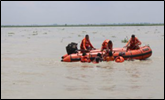
NDMA & UP SDMA conducted a flood mock exercise in Uttar Pradesh on June 24 & June 26, 2025, the exercise tested response mechanisms & enhanced preparedness for flood disasters. It was conducted for all 118 Tehsils of 44 Flood sensitive districts of UP.
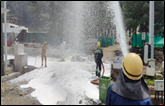
A mock exercise was conducted for Amarnath Yatra on June 28, 2025, for the Southern Route (Pahalgam Axis) in Anantnag District, J&K to test response plans & stakeholder preparedness for a safe & well-coordinated pilgrimage.
Exercise Suraksha Chakra
A multi-state integrated mock drill was conducted from August 1, 2025, across 55 locations in Delhi-NCR, covering 18 districts (11 in Delhi, 5 in Haryana, and 2 in Uttar Pradesh). Organised by NDMA in collaboration with the Indian Army, DDMA, and SDMAs of Haryana and Uttar Pradesh, this was the first of its kind integrated mock drill in the region. The drill simulated a large-scale earthquake to evaluate emergency preparedness, inter-agency coordination, and citizen participation. Activities included real-time sirens, evacuation drills, medical simulations, and SOP testing across schools, hospitals, metros, and residential complexes.
Dos and Don’ts During a Disaster
When it comes to disaster preparedness, public awareness of dos and don’ts during emergencies is crucial. It empowers individuals to act quickly, avoid panic, and reduce risk to loss of life.
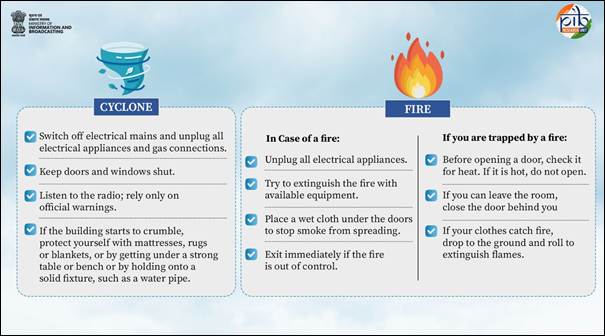
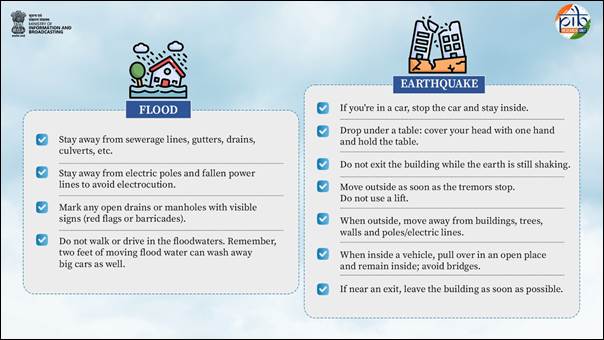
Conclusion
India’s evolving disaster management approach emphasises on pre-emptive, technology-enabled measures through mock drills and public awareness. Exercise Suraksha Chakra and other state-level drills continue to strengthen our nation’s capacity during emergencies. With vigilant citizenry and responsive institutions, India continues to move toward its vision of a disaster-resilient nation.
References
Ministry of Home Affairs
Disaster Management Act, 2005:
https://ndmindia.mha.gov.in/ndmi/images/The%20Disaster%20Management%20Act,%202005.pdf
National Disaster Management Authority
https://ndma.gov.in/about-us/introduction
https://www.ndma.gov.in/Governance/guidelines
https://x.com/ndmaindia/status/1951295341371752713
https://x.com/ndmaindia/status/1951295354332172526
https://x.com/ndmaindia/status/1951295375106592783
https://x.com/ndmaindia/status/1939005226633363667
https://x.com/ndmaindia/status/1938494836212125991
https://x.com/narendramodi/status/1634223304327286790
https://x.com/DC_Gurugram/status/1951274840230445397
https://ndma.gov.in/sites/default/files/PDF/ndmp-2019.pdf
https://ndma.gov.in/sites/default/files/PDF/national-dm-policy2009.pdf
https://ndma.gov.in/sites/default/files/PDF/Guidelines/DMEx_Guidlines_Oct_2024.pdf
Annual Report (2023-24): https://ndma.gov.in/sites/default/files/PDF/Reports/Annual_Report_2023-24_Eng.pdf
National Disaster Response Force
https://www.ndrf.gov.in/en/about-us
Delhi Disaster Management Authority
https://ddma.delhi.gov.in/ddma/objectives-0
United Nations Office for Disaster Risk Reduction
https://www.undrr.org/implementing-sendai-framework/what-sendai-framework
Click here to see PDF.
*****
SK |AKS
(Backgrounder ID: 155004)
Visitor Counter : 10
Read this release in:
Hindi